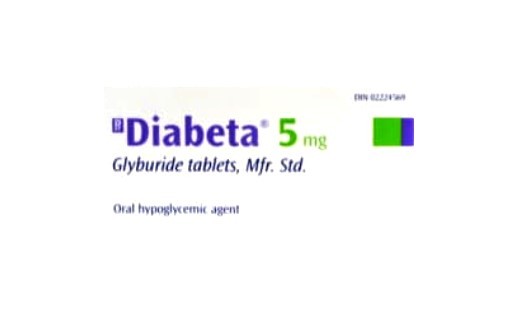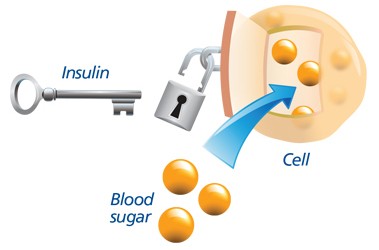- Your cart is empty
- Continue Shopping
Product
- Canaan Pharmacy Online Pharmacy | Online Canadian Pharmacy
- Need More Information Call Us 1-833-356-6337
What is Diabeta (Glyburide)?
Diabeta is an oral diabetes medicine that helps you control your blood sugar levels. Its common name, which is also the generic version, is Glyburide, or Glibenclamide. It is prescribed alongside proper dietary management, exercise and weight reduction for adults with type 2 diabetes, and is not for the treatment of type 1 diabetes.
How does Glyburide work?
Glyburide (Diabeta) lowers blood sugar by stimulating the pancreas to secrete insulin. It belongs to a large class of antidiabetic drugs called sulfonylureas. These drugs bind to beta cells in your pancreas and stimulate them to release more insulin into the rest of your body.
How and when to use this medication
Diabeta is used for the treatment of type 2 diabetes, and not for the treatment of type 1 diabetes. The dose amount and dose schedule may be different for different patients. Always remember to follow your doctor’s orders or the directions on the label. You should take the tablets during or immediately after meals.
Diabeta dosage
The usual dose for adults is between 2.5 to 10 mg taken once a day, but it can be as low as 1.25mg and as high as 20 mg. The tablets should be taken with your breakfast or with your first main meal of the day. A dose of more than 10 mg should be taken in two divided doses. Dose increases should be made in increments of no more than 2.5 mg, at weekly intervals, based upon your blood sugar response. Your doctor may adjust your dose as treatment continues, but the dose is usually not more than 20 mg per day. Dosing for children should be determined individually by your doctor.
If you are transferring from other oral diabetic treatments, you should do so conservatively, with your initial daily dose being between be 2.5 to 5 mg. When transferring from oral diabetic drugs other than Chlorpropamide, there is not usually a transition period, and you may not need an initial priming dose. When transferring from Chlorpropamide, specific care should be applied during the first two weeks because the remaining Chlorpropamide in your body, and the overlapping effects of the drug, may provoke low blood sugar levels.
If you are transferring from more than 40 daily units of insulin, you may be started on a daily dose of 5 mg along with a 50% reduction in insulin. With the progressive withdrawal of insulin, the increase of Diabeta is usually administered in increments of 1.25 to 2.5 mg every two to ten days from then onward.
Daily doses that exceed 20 mg are not recommended.
If you should happen to miss a dose, take it as soon as possible. Although, if it is almost time for your next dose, do not take the missed dose and simply go back to your regular dosing schedule. Do not take double doses.
Warnings and Precautions
A proper diet, exercise and weight reduction are important to help you control your diabetes. Your blood sugar may change in some situations, however. For example, if you are under stress or suffering from a certain illnesses. During such times, your doctor may need to modify your dose.
Diabeta may cause low blood sugar, especially if you skip a meal, exercise strenuously, drink alcohol or take another antidiabetic medication along with Glyburide. Elderly patients may be more likely to have low blood sugar when taking this medication.
Drugs that can interact with this medication are:
- Diuretics (water pills)
- Corticosteroids (such as prednisone)
- ACE inhibitors (a drug used to treat high blood pressure or hypertension)
- Birth control pills
- Certain kinds of cold and allergy drugs
Side effects
As with any type of medication, along with its medicinal effects, Diabeta is also associated with some side effects.
Common negative effects include the following:
- Low blood sugar (hypoglycemia)
- Nausea
- Heartburn
- Feeling “full”
- Vomiting
- Diarrhea
- Abdominal pain
- Weight gain
- Allergic skin reactions (itchiness, rash, eruption)
- Increased sensibility to light
- Visual disturbances
Possible severe negative effects include:
- Blood disorders (unusual bruising or bleeding)
- Liver problem (yellowing of the eyes or skin)
- Allergic reaction (difficult breathing, hives, decreased blood pressure)
- Allergic inflammation of blood vessels (vasculitis)
Talk to your health care provider about any side effect that bothers you or does not go away. These are not all the possible side effects. Call your doctor for medical advice about side effects.
What is Diabeta (Glyburide)?
Designed to be taken orally, Diabeta is an antidiabetic medicine that helps to improve blood sugar control. It is commonly prescribed for adults who have diabetes mellitus. The active ingredient in Diabeta is glyburide, a sulfonylurea that has a stimulating effect on the pancreatic release of insulin. In addition to 2.5mg formulation, Diabeta is also available in a higher dosage strength of 5mg. Diabeta is a prescription medicine produced by Sanofi, a Paris-based pharmaceutical corporation.
What is it used for?
Diabeta is commonly used in adult patients with type II diabetes to improve blood glucose control. It is often used as an adjunctive treatment along with non-pharmacological treatments such as diet and exercise. Be aware that Diabeta is not indicated for the treatment of type I diabetes, nor it is effective in treating diabetic ketoacidosis. Generally, the concomitant use of Diabeta and Tracleer should be avoided. As with other oral hypoglycemic agents, Diabeta should not be used concurrently with insulin. This particular drug combination can lead to the development of severe heart conditions.
Why use it?
Diabeta is highly effective in treating type II diabetes, helping patients to obtain better glycemic control.
What is Glyburide 2.5mg?
Glyburide 2.5mg is an oral antidiabetic drug (OAD) that is used as an adjunctive therapy alongside diet modification and exercise to treat patients diagnosed with type 2 diabetes mellitus. Glyburide is classified as a sulfonylurea, which functions by simulating the β cells of the pancreas to release both basal insulin secretion and meal-stimulated insulin. This class of OAD also works by increasing the number and sensitivity of insulin receptors; increasing peripheral glucose utilization; and decreasing glucose production in the liver.
What is it used for?
Patients are prescribed with this medication when lifestyle modifications alone are ineffective. Glyburide 2.5mg is administered orally with the first main meal of the day to reduce the risk of hypoglycemia. The starting dosage is usually 2.5 to 5mg once daily. The dose may be gradually increased by 2.5mg until the desired treatment response is obtained. The maintenance dosage is between 1.25 to 20mg orally once daily, as single or divided doses. The maximum dose is 20mg of Glyburide once daily. Patients who are hypersensitive to other OADs may be prescribed a lower initial dose of 1.25mg.
Why use this medication?
Consistent Glyburide intake, in combination with diet control and adequate exercise, will help to reduce elevated blood sugar level.
What is Glyburide 5mg?
Glyburide 5mg is an antidiabetic agent that is indicated for patients with type 2 diabetes mellitus who had failed to control their high blood glucose level via diet modification and exercise alone. This oral antidiabetic drug (OAD) is a type of sulfonylurea from the insulin secretagogue class of medications, which reduces elevated blood level by stimulating the beta cells of the pancreas to secrete more basal insulin and meal-stimulated insulin. Besides that, Glyburide also decreases hepatic production of glucose while increasing the peripheral utilization of glucose and the quantity and sensitivity of insulin receptors in the body.
What is it used for?
Adult patients are usually prescribed with an initial dosage of Glyburide 5mg, taken orally once daily. The initial dose for geriatric patients is 1.25mg, also taken orally once daily. The dose for adult patients may be increased gradually by 2.5mg over five to seven days until adequate glycemic control is achieved. The maximum dosage of Glyburide is 20mg daily, which may be taken as single or divided doses. It is important that patients take this drug together with the first main meal of the day to prevent episodes of hypoglycemia. If patients eat a light breakfast, they should wait until they eat a larger meal to take the daily dose. Patients with known hypersensitivities to OADs may be prescribed with a lower initial dosage instead.
Why use this drug?
The use of Glyburide alongside regular exercise and a healthy diet helps to manage and control high blood sugar levels.






